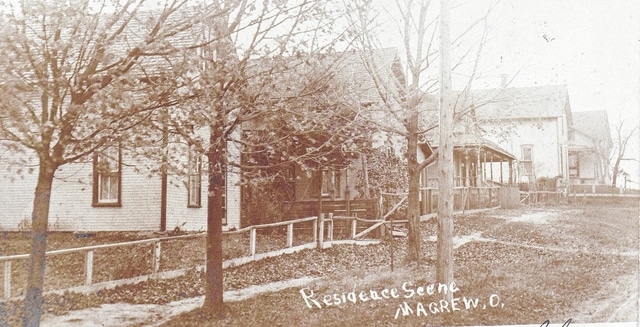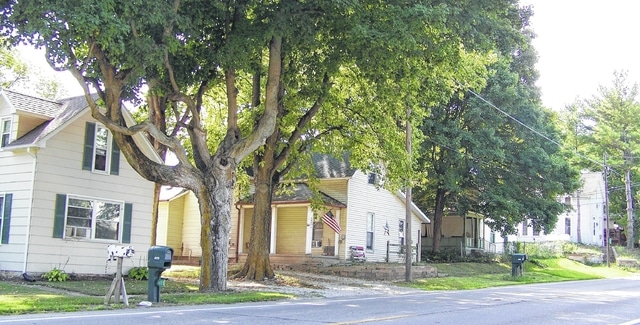

The “Then” postcard is identified as “Residence Scene Magrew, O.” and postmarked Magrew, Ohio 1907. It shows several homes on the southwest part of the main street of the village with one utility pole in the area between the road and the rather crude serviceable fence going up the hill in front of the homes. It is difficult to identify the condition of the roadway.
This postcard presents a puzzle in Champaign County history records. Knowing that Westville was called Magrew, researching was expected to be simple. The postmark stamped on the backside of the postcard of Magrew, Ohio, in 1907, would make one think that the town was called Magrew in 1907. The History of Champaign County, published by Beers in 1881, talks about Westville, Ohio, being in Mad River Township at the intersections of Valley Pike, Urbana Pike, and St. Paris Pike, with 150 residents. It mentions Archibald Magrew as the first owner of the land in 1810 and the village planner of Westville. There was no mention of a village named Magrew. Looking in The History of Champaign County, compiled by Judge Middleton in 1917, reveals that a man by the last name of “West” was the first white settler to live on this land in 1805, now occupied by the village of Westville, and that “Magrew” was the first owner of the land and the person who plotted lots for the town called Westville. It is not known why the post office was called Magrew until at least 1907. Somehow the town was referred to as “West”ville, but the post office name was“Magrew” stayed for an extended period of time.
Middleton’s history goes on to say that Westville was the first village planned out in Mad River Township. That Mad River Township was one of the three original townships of the “then” newly formed Champaign County, Ohio. Basil West, a pioneer squatter in 1805, was the first to live on the later site of the town. He was a poor man, but an honest and hard working pioneer. It was recorded that he and his family would not have been able to survive without the cow which Mr. West purchased, on credit, when he came to the township.
Many facts are known about the village. The village land that was laid out Feb. 14, 1815, had been first purchased from the government by Archibald Magrew, a native of Pennsylvania. He, his wife, Ruth, and family of four boys and one girl, settled here about 1810, building his home along Urbana Pike, to the east, outside the village he planned. Magrew went on to become a substantial citizen of Mad River township until his death in 1855, and his sons and grandsons carried on his legacy for years afterward. Undoubtedly, he felt that the site he chose would eventually become the seat of a flourishing village, and it did for a time.
In 1818 the first town lot was sold to Abraham Stephens, and he built his house on that northwest corner of the only crossroads in the town. Jeremiah Hoffman erected the second house in that same year, and about the same time a man by the name of Cook built a shop and established a carding machine. Curtis Thompson, a carpenter, also appeared on the scene in 1818 and found plenty of work in his line of business. The year 1818 seemed to be filled with building operations; dwellings, store buildings, shops, and even a large log school building arose that year. The first teacher was William Allen. Some years later a two story brick graded school house was built to expand the educational opportunities of the community. Among the first merchants were Joseph B. Acre, John L. Stephens, and John Arrowsmith.
Community’s first church built by Methodists
The first church in the village, a brick structure the Methodists built about 1826, burned during the winter of 1877-78. It was replaced by the present building during the following year and is still a thriving church. The Universalists erected a church building largely through the benevolence of David Loudenback, who contributing the major portion of the eight thousand dollars which the building cost. This is now the unique home of artist Mike Major and his wife Jane. In 1876 the Grange (Patrons of Husbandry) erected a two-story brick building, thirty three by fifty feet, at a cost of three thousand six hundred dollars. The Grange shared the building for a short time with the Sons of Temperance.
Among other business enterprises of the village in early years were the following: Nichols & Hoak, grocers; John Richardson, general store; H. H. Baker, steam machine shop; and Minnich Brothers, blacksmiths. There were two general stores in the village in 1917, operated by W. P. Ferst and Earl Walters, respectively. There had been doctors in the town since its earliest history. Dr. R R. McLaughlin located in the village in 1861 and practiced there until his death in 1891. He also served as postmaster for several years. His son, Clarence M., born in Westville in 1864, went to medical college and returned to practice with his father in Westville. In June, 1917, just ten years after the“then” postcard was postmarked, the population was given as two hundred and eighty, of which thirty-four were children. There were sixty dwellings in the village. It is understandable why some called the village Magrew, Ohio, as the post office was called Magrew. But the town seems to have always be recorded in old history books as Westville. By the way, it has also been referred to by some other names according to one source, such as Smithville and Hartford/Four Corners.
Today’s Westville
“Now” the village of Westville, Ohio, has a post office of the same name of Westville. The “Now” photo looks different and yet similar. It features several houses, with modern siding, along the upward slope of the road; a nicely paved wider roadway, with more utility poles and lines; no fences; and rural mail delivery instead of having to walk to the post office to pick up your mail. The brick two story schoolhouse (not visible but across the street) is still serving the community. It is now a new church in the village’s revived fine old brick schoolhouse. A few newer type businesses are located in the village but it is now mostly houses.
Now in 2016, Westville is two hundred and one years old and has always been an unincorporated village. It is still located in the northern part of Mad River township, in sections 11 and 17. It is four miles due west of Urbana on the Piqua-Urbana road (US Rt 36), where it crosses Rt. 560 (once called Anderson Creek Pike north and Mad River Pike south among other names through the years.). It is one-half mile north of the old Pennsylvania railroad (or earlier the C.C.& I.C. Railroad). For some reason this village, unlike many of the others of the county, was not located on a stream of any kind, but is about equal distant from Anderson creek on the east and Nettle creek on the west. In its beginning it was the most densely settled community in Mad River township. It had a train station nearby and it still has a post office. But now it seems to be content to be a small close knit group of residents living in the quiet unincorporated village of Westville known by many because of it’s location on the busily traveled US Rt. 36 highway.



